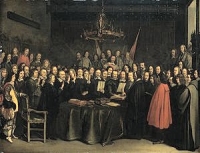Historic Moments in International Law
The Origins of the Modern State System
 By:
James G. Apple, Editor-in-Chief, International
Judicial Monitor and
President, International Judicial Academy
By:
James G. Apple, Editor-in-Chief, International
Judicial Monitor and
President, International Judicial Academy
A part of the birth process of the modern state system was singularly bizarre – two men were thrown out of window.
But the real origins of the state system, from an earlier time, revolve around an equally pedestrian architectural feature, a door. What happened on that door literally shook the foundations of western civilization.
The door in question was attached to a church in a small town in northern Germany. It was, of course, the door of the All Saints’ Church (university church) in Wittenburg where the monk and professor Martin Luther tacked his famous 95 theses challenging certain practices of the Roman Catholic Church. The surprising part about that action was not necessarily that it happened – it was common practice in that academic city for professors to post writings of one kind or another on the door as an impetus for discussion and debate – but the speed at which the challenges traveled, first to the immediate countryside (two weeks), then throughout Germany (one month), and then throughout all of Europe (six months). The speed of this dispersal of theological ideas was remarkable, a demonstration of widespread dissatisfaction with religious practices and perhaps even with the Christian theology as announced and enforced from Rome. Luther sent a letter with his 95 theses enclosed to the local archbishop, making his challenges a public issue. The archbishop duly forwarded the epistle to the Pope in Rome, while copies of the theses were printed and circulated throughout Germany. These actions precipitated a “pamphlet war” and eventually a real one.
Luther’s singular action took place on October 31, 1517. By the end of the century all of Europe was in a political turmoil that is now known as the Reformation.
In the ensuing years, Protestant theology became a dominant
force in many parts of the Holy Roman Empire. One of the
centers of that theology was Prague, the capital of what
is now the Czech Republic, but was then the major city
in the German region known as Bohemia.
In 1617, one hundred years after Luther’s posting
of his dissatisfactions on the church door in Wittenburg,
Ferdinand of Styria, a “rabid Catholic,” a
Habsburg, and heir apparent to the throne of the Holy
Roman Empire, was crowned king of Bohemia. His coronation
marked the end of the religious toleration for Protestants
in the area that had been brought about earlier in 1609
by one of Ferdinand’s predecessors. Regents (representatives)
of Ferdinand quickly began to harass Protestants in Bohemia,
censoring their publications and preventing them from
holding public offices. The Protestant nobility of Bohemia
rebelled.
The rebellion of nobles in Prague that proved to be such
a momentous event took the form of an “act of defenestration.”
On May 23, 1618 one hundred armed nobleman pressed into
the council rooms of Prague Castle, grabbed two of Ferdinand’s
regents (and possibly a secretary) who were present to
negotiate with the nobles, and threw them out one of the
council room windows, which was 50 feet above the Castle
grounds. Although the two regents survived, having landed
in a dung heap, the event caused such outrage among Ferdinand’s
Catholic followers that armed hostilities soon followed,
the beginnings of what history now calls the Thirty Years
War. The armies of Spain, France, Sweden and Denmark eventually
marched into German lands and decimated both the countryside
and the population. It has been estimated that 40% of
the population of the Germanic lands of the Holy Roman
Empire were killed in that conflict, one that involved
“religion, religious zeal, and religious hatred.”
Thirty years later, in 1648, the fighting finally stopped.
On October 24 of that year representatives of the warring
Catholics and Protestants and of the Holy Roman Empire
gathered in two cities in the German area of Westphalia
(Munster and Osnabruck) to negotiate treaties officially
terminating the hostilities. The Peace of Westphalia not
only ended the Thirty Years War, but it also ended the
Eighty Years War between Spain and the Netherlands, and
for all practical purposes it marked the end of the Holy
Roman Empire.
Under the terms of the treaty, Switzerland and the Netherlands
became independent states, France and Sweden gained territory,
and the boundaries of the small states of German territory
were stabilized. These results laid the foundation for
the modern state system of Europe, which in turn provided
a fertile soil for the growth and development of a “law
of nations.”
But the Peace of Westphalia did not only provide the origins
of the modern state system from which a law of nations
could grow and mature, it was also the birthplace of a
new idea in political science, one that has both nourished
and impeded the cause of international law, the doctrine
of state sovereignty.
